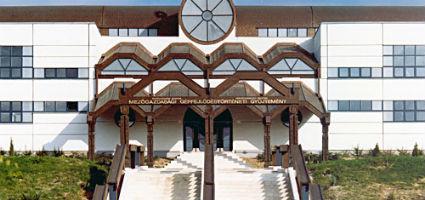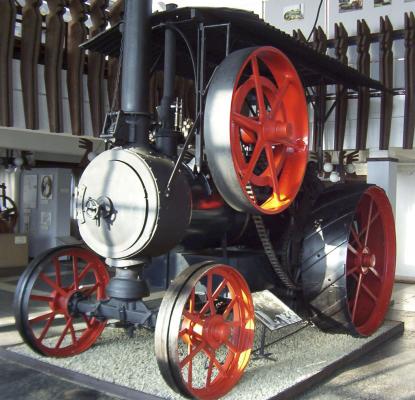2024. November 26. Tuesday
St. Stefan University Agricultural Tool and Machine Development Museum - Gödöllő
 |
Address: 2103, Gödöllő Páter Károly utca 1.
Phone number: (28) 410-210, (28) 522-000 /1050
E-mail: muzeum@gepmuzeum.szie.hu
Opening hours: Mon-Fri 9-16, Sat 9-14
|
Museum tickets, service costs:
|
Ticket for adults
|
800 HUF
|
|
|
Ticket for students
|
400 HUF
|
|
|
Ticket for pensioners
|
400 HUF
|
|
|
Ticket for families
|
2000 HUF
|
/ family
|
|
Guide
|
5000 HUF
|
|
|
Photography
|
1500 HUF
|
|
|
Video
|
2500 HUF
|
The application of fuel brought on revolutionary changes after the simple prime movers operated by wind, water and human power. It began with the operation of steam engines fuelled by coal and other fuel.

However, application of steam engines came considerably late in agriculture. The Clayton-Shuttleworth Company in Lincoln made the first steam engine in 1845.
Experiment to invent a steam engine had been going on for 100 years by the time the first one was invented. The first real steam engine was born in 1769 when Jamed Watt patented his first machine. The Boulton-Watt Factory in England opened the first steam machine factory in 1775.
The first experiments to invent an agricultural steam engine was made by Richard Trevithick in 1811. Then Alexander Dean invented his steam engine on wheels in 1841. Mass production of steam locomobils were began to be produced by the Clayton-Shuttleworth Company in 1845.
Soon, experiments to mechanize plowing began which brought on the development of new direct and indirect procedures. A steam plowing machine was shown in Lancashire in 1837. In 1849, James Usker invented a steam gigging plough. By the mid 19th century a unified steam plough system developed based on the work of John Fowler with the Fowler type plough engine.
The highest level of agricultural steam engines came with the self-propelling plough machines. Agricultural steam engines were used until the middle of the 20th century. Their heydays was in the last decades of the 19th century and the first three decades of the 20th century.

However, application of steam engines came considerably late in agriculture. The Clayton-Shuttleworth Company in Lincoln made the first steam engine in 1845.
Experiment to invent a steam engine had been going on for 100 years by the time the first one was invented. The first real steam engine was born in 1769 when Jamed Watt patented his first machine. The Boulton-Watt Factory in England opened the first steam machine factory in 1775.
The first experiments to invent an agricultural steam engine was made by Richard Trevithick in 1811. Then Alexander Dean invented his steam engine on wheels in 1841. Mass production of steam locomobils were began to be produced by the Clayton-Shuttleworth Company in 1845.
Soon, experiments to mechanize plowing began which brought on the development of new direct and indirect procedures. A steam plowing machine was shown in Lancashire in 1837. In 1849, James Usker invented a steam gigging plough. By the mid 19th century a unified steam plough system developed based on the work of John Fowler with the Fowler type plough engine.
The highest level of agricultural steam engines came with the self-propelling plough machines. Agricultural steam engines were used until the middle of the 20th century. Their heydays was in the last decades of the 19th century and the first three decades of the 20th century.
